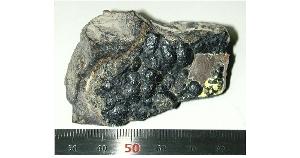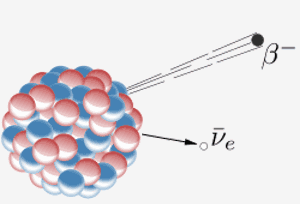The chemical element francium is classed as an alkali metal. It was discovered in 1939 by Marguerite Perey.

Data Zone
| Classification: | Francium is an alkali metal |
| Color: | silver-gray-metallic (presumed) |
| Atomic weight: | (223), no stable isotopes |
| State: | solid |
| Melting point: | 27 oC , 300 K |
| Boiling point: | 677 oC, 950 K |
| Electrons: | 87 |
| Protons: | 87 |
| Neutrons in most abundant isotope: | 136 |
| Electron shells: | 2,8,18,32,18,8,1 |
| Electron configuration: | [Rn] 7s1 |
| Density @ 20oC: | 1.873 g/cm3 |
Reactions, Compounds, Radii, Conductivities
| Atomic volume: | 71.07 cm3/mol |
| Structure: | believed to be bcc: body-centered cubic |
| Hardness: | – |
| Specific heat capacity | – |
| Heat of fusion | 2 kJ mol-1 |
| Heat of atomization | 73 kJ mol-1 |
| Heat of vaporization | 64 kJ mol-1 |
| 1st ionization energy | 384 kJ mol-1 |
| 2nd ionization energy | – |
| 3rd ionization energy | – |
| Electron affinity | – |
| Minimum oxidation number | 0 |
| Min. common oxidation no. | 0 |
| Maximum oxidation number | 1 |
| Max. common oxidation no. | 1 |
| Electronegativity (Pauling Scale) | 0.7 |
| Polarizability volume | 48.7 Å3 |
| Reaction with air | – |
| Reaction with 15 M HNO3 | – |
| Reaction with 6 M HCl | vigorous, ⇒ H2, FrCl |
| Reaction with 6 M NaOH | vigorous, ⇒ H2, FrOH |
| Oxide(s) | – |
| Hydride(s) | – |
| Chloride(s) | – |
| Atomic radius | – |
| Ionic radius (1+ ion) | 194 pm |
| Ionic radius (2+ ion) | – |
| Ionic radius (3+ ion) | – |
| Ionic radius (1- ion) | – |
| Ionic radius (2- ion) | – |
| Ionic radius (3- ion) | – |
| Thermal conductivity | 3.61 W m-1 K-1 |
| Electrical conductivity | – |
| Freezing/Melting point: | 27 oC , 300 K |

This uranium ore sample contains about 100 000 atoms of francium-223 (3.3 x 10 -20 g). Francium is radioactive; less than 30g of it exists on Earth at any given time. Image Ref. (1)
Discovery of Francium
Francium was discovered by Marguerite Perey in 1939 when she was researching the radioactive decay of actinium-227.
The discovery took place at the Curie Institute in Paris. The element takes its name from the country of its discovery – France.
The discovery began, in 1935, when Perey aged 26, read a research paper claiming that American scientists had discovered beta particles being emitted by actinium which had a higher amount of energy than normal.
Perey was curious about this finding, and already being an expert on actinium related work, she decided to carry out her own experiments on actinium. She produced an ultra-pure actinium sample and studied its radiation. Perey discovered that about 1% of actiniums radioactivity was caused by it emitting alpha particles, not beta particles.
Perey had discovered that actinium-227 could decay by emitting a helium nucleus (also called an alpha particle) from its own nucleus. The daughter nucleus formed was a previously undiscovered element which she chose to call francium to honor her home country, France.
227Ac → 223Fr + 4He
With 87 protons the new element belonged in Group 1 of the periodic table, joining the other five alkali metals: lithium, sodium, potassium, rubidium and cesium.
The discovery of francium completed humankind’s discoveries of naturally occurring elements.
All elements discovered since then have been discovered when the element has been produced in the laboratory.


A nucleus emits a beta-particle (an electron) and an antineutrino. The result of this is that a neutron in the nucleus turns into a proton. When element 87 in the periodic table (francium) does this, the extra proton means that it becomes element 88 (radium).
Appearance and Characteristics
Harmful effects:
Francium is highly radioactive.
Characteristics:
Francium is a heavy, unstable, radioactive metal with a maximum half-life of only 22 minutes. It has a low melting point (27 oC, 81 oF) and, if enough of it could be accumulated, it would be liquid in a warm room.
Francium is the second rarest element in the Earth’s crust, next to astatine. Less than thirty grams of francium exists on Earth at any given time.
Francium is the least electronegative of all the elements, therefore it should be the most chemically reactive alkali metal. Unfortunately, it is not available in sufficient quantities to show it reacting with water – it is made in tiny quantities in particle accelerators. In theory, its reaction with water would be more violent than cesium’s and very much more violent than sodium’s.
Francium has been studied most recently at Stony Brook University, New York. Scientists there trapped up to ten thousand francium atoms at a time using laser beams in a magnetic field in order to measure their properties.
Uses of Francium
Commercially, there are no uses for francium, due to its rarity and instability. It is used for research purposes only.
Francium Decay
Francium’s isotopes, with mass numbers ranging from 200 to 232, most commonly undergo alpha- or beta-decay.
Here are just a few examples of francium’s decay paths:
Francium-223 is the element’s longest lived isotope. It has a half-life of 22 minutes. It can emit an alpha-particle (a helium nucleus) to form astatine-219 or a beta-particle to form radium-223. (A beta-particle is an electron which is emitted from a nucleus when a neutron converts to a proton.)
Francium-221 has a half-life of 5 minutes. It can emit an alpha-particle to form astatine-217 or a beta-particle to become radium-221.
Francium-216 has a half-life of 0.7 microseconds. It can emit an alpha-particle to form astatine-212 or a positron to form radon-216.
Francium-212 has a half-life of 19 minutes. It can emit an alpha-particle to form astatine-208 or capture an orbital electron to form radon-212. (2) (During orbital electron capture, the nucleus captures one of the atom’s own electrons and emits a neutrino.)
Abundance and Isotopes
Abundance earth’s crust: ~ 0 parts per million, ~ 0 parts per million
Abundance solar system: ~ 0 parts per billion by weight, ~ 0 parts per billion by moles
Cost, pure: $ per 100g
Cost, bulk: $ per 100g
Source: Francium occurs naturally as a result of the alpha radioactive decay of actinium.
Isotopes: Francium has 33 isotopes whose half-lives are known, with mass numbers 200 to 232. None are stable. 223Fr has the longest half-life at 21.8 minutes.

References
- Photo by Konrad Roeder
- E.K. Hyde, a. Ghiorso, G.T. Seaborg, Physical Review., 1950, 77, p765, Issue 6.
Cite this Page
For online linking, please copy and paste one of the following:
<a href="https://www.chemicool.com/elements/francium.html">Francium</a>
or
<a href="https://www.chemicool.com/elements/francium.html">Francium Element Facts</a>
To cite this page in an academic document, please use the following MLA compliant citation:
"Francium." Chemicool Periodic Table. Chemicool.com. 11 Jan. 2015. Web. <https://www.chemicool.com/elements/francium.html>.
I found this information very interesting, it says that francium is only useable for 20 or so minutes but what happens to francium once it loses its radioactivity?
Good Question
Hi RWhite84 and Amy. Francium ceases to be francium and turns into astatine, radon or radium. We’ve written a section headed Francium Decay which discusses this. Scroll up a bit on this page to see it.
this may have been awnsered but why does francium decay?
Hi Michael, the quickest answer is that francium decays because it’s radioactive, which means its nucleus is unstable. The EPA has a nice summary part of which I’ve quoted:
What causes atoms to be radioactive?
Atoms found in nature are either stable or unstable. An atom is stable if the forces among the particles that make up the nucleus are balanced. An atom is unstable (radioactive) if these forces are unbalanced… An unstable nucleus will continually vibrate and contort and, sooner or later, attempt to reach stability by some combination of means:
* ejecting neutrons, and protons
* converting one to the other with the ejection of a beta particle or positron
* the release of additional energy by photon (i.e., gamma ray) emission.
Read more here: http://www.epa.gov/rpdweb00/understand/radiation.html
If you would like to investigate this topic in a more advanced way, a good place to start is to search for information about the electric force between protons that tries to disintegrate the nucleus and the strong nuclear force that tries to hold the nucleus together.
When was this specific part of the website published?
Thanks for your question Nl. That info is in the citation section. It’s January 11, 2015.